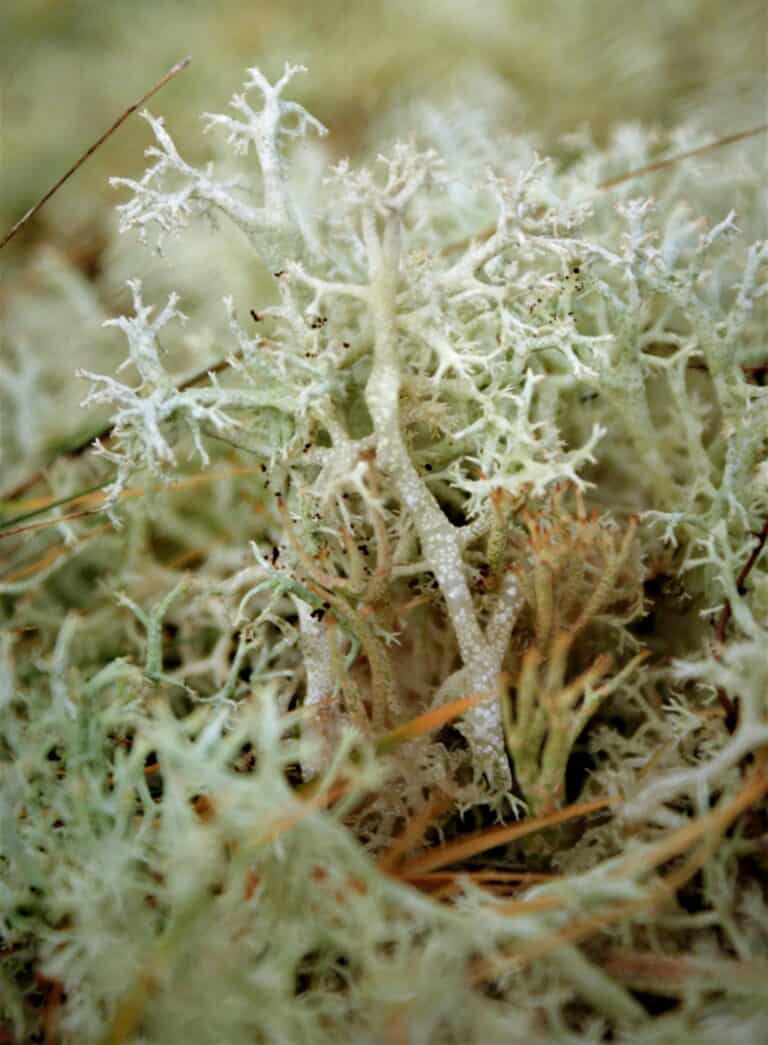If you want to survive in the wilderness against all odds, you’ll have to learn how to make use of every single resource that Mother Nature places at your disposal. When it comes to food, that means things that you ordinarily wouldn’t eat in a hundred years.

reindeer moss
Reindeer Moss is a great example. This crunchy, creepy, uh, moss, is… you know what, reindeer moss doesn’t look like moss at all. Exactly what is reindeer moss anyway?
Reindeer Moss isn’t a true moss, but instead a type of lichen, Cladonia rangiferina. Reindeer moss, like all lichens, consists of bacteria living among the growing strands of certain types of fungus, forming a symbiotic organism.
It’s hard to say where reindeer moss first got its name, or its common name that refers to it as moss in the first place. Some folks say it’s called reindeer moss because it looks like reindeer antlers. Others say it is because it’s an important food for caribou, a type of deer.
In any case, it’s not really moss but it’s really edible by people, and can save your life in certain circumstances. There’s a lot more you’ll want to learn about it, so read on below.
Are Moss and Lichens the Same Thing?
No, they are not. Mosses are actually a type of true plant, just on a tiny scale. However, they’re a sort of nonvascular plant, ones that don’t grow any flowers.
Mosses typically look like a blanket or carpet growing across an underlying surface in a dense formation. Basically, they are all leaves and not much else!
Lichens, like reindeer moss, are different though often confused for one another by the uninitiated. Lichens can take the form of either algae or certain types of bacteria that live among the filament structures of different types of fungi.
Sometimes, yeast is another component in this symbiotic relationship that forms a type of composite organism that is functionally more than the sum of its parts.
Ultimately, lichens of any type are not closely related to any type of moss or other plant life. Notably, though, when lichens do grow on plants, usually trees, they don’t parasitize them, using them only as a surface for their own existence.
Do Reindeer Really Eat Reindeer Moss?
Yes, they sure do! Like I said up above, some folks associate the name of reindeer moss with reindeer, or caribou, because they eat it.
It’s not only true, but they eat a ton of the stuff and it is a crucially important foodstuff for them when other kinds of food are scarce or totally non-existent.
And because it’s so important to caribou populations this makes reindeer moss extremely important ecologically and commercially in countries where reindeer are important livestock animals or wildlife.
Can People Safely Eat Reindeer Moss?
Yes, reindeer moss is safe for people to eat but with certain reservations we’ll talk about in a moment. It can provide you with some calories, carbohydrates, and various nutrients though good scientific information on its actual nutritional content is scarce.
The major one is that you must take care not to confuse it with any other kind of plant or fungus because a case of mistaken identity might be fatal if you wind up with a poisonous look-alike.
The presence of dangerous bacteria, if eaten raw, is another major concern, as with all wild-caught or gathered edibles.
Reindeer moss also has a tendency, if not cooked properly, to cause significant indigestion and potentially diarrhea. The chances of this go up in direct proportion to the quantity ingested.
Reindeer Moss Can Be Safely Eaten Raw
Yes, it can be if you are in a real pinch and have no way to boil it or prepare it otherwise. However, you should brace yourself.
Reindeer moss is singularly nasty when eaten raw. It is crunchy and tough at the same time, and invariably has a disgusting ashy, dirty, slimy taste to it. This is especially likely if it is growing on a rotting substrate.
However, if you brave pioneers haven’t described the flavor as woody or mushroom-like in character. The very best that you can hope for is that it just tastes bland and plain.

Prepare This Stuff if You Can!
If you have any opportunity in the wild, you should prepare reindeer moss prior to eating it. This will make it safer, by killing harmful bacteria, and also make it taste better or at least taste less offensive.
A traditional method is to boil it for about 30 minutes, and then soak it in cool water several times, periodically changing out the water to leach out any nasty contaminants.
Reindeer moss is also dried and then ground or pounded after boiling to serve as a thickener or ingredient in various kinds of soup, stew, and porridge. You can use it to bulk up other foods and add a little bit of extra nutrients and calories.
The post Reindeer Moss in the Wild – What You Should Know appeared first on Survival Sullivan.
https://www.survivalsullivan.com/reindeer-moss/
 CampingSurvivalistHuntingFishingExploringHikingPrivacy PolicyTerms And Conditions
CampingSurvivalistHuntingFishingExploringHikingPrivacy PolicyTerms And Conditions
